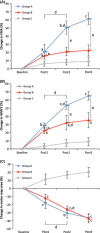Differential effect of conditioning sequences in coupling inhibitory/facilitatory repetitive transcranial magnetic stimulation for poststroke motor recovery
- PMID: 24422912
- PMCID: PMC6493039
- DOI: 10.1111/cns.12221
Differential effect of conditioning sequences in coupling inhibitory/facilitatory repetitive transcranial magnetic stimulation for poststroke motor recovery
Abstract
Introduction: While neuromodulation through unihemispheric repetitive transcranial magnetic stimulation (rTMS) has shown promise for the motor recovery of stroke patients, the effectiveness of the coupling of different rTMS protocols remains unclear.
Aims: We aimed to test the long-term efficacy of this strategy with different applying sequences and to identify the electrophysiological correlates of motor improvements to the paretic hand.
Results: In our sham-controlled, double-blinded parallel study, 48 stroke patients (2-6 months poststroke) were randomly allocated to three groups. Group A underwent 20-session rTMS conditioning initiated with 10-session 1 Hz rTMS over the contralesional primary motor cortex (M1), followed by 10-session intermittent theta burst stimulation (iTBS) consequently over the ipsilesional M1; Group B underwent the same two paradigms but in reverse; and Group C received sham stimulation that was identical to Group A. We tested cortical excitability and motor assessments at the baseline, postpriming rTMS, postconsequent rTMS, and at 3-months follow-up. Group A manifested greater improvement than Group B in Fugl-Meyer Assessment (FMA), Wolf Motor Function testing (WMFT) score, and muscle strength (P = 0.001-0.02) post the priming rTMS. After the consequent rTMS, Group A continued to present a superior outcome than Group B in FMA (P = 0.015) and WMFT score (P = 0.008) with significant behavior-electrophysiological correlation.
Conclusions: Conditioning the contralesional M1 prior to ipsilesional iTBS was found to be optimal for enhancing hand function, and this effect persisted for at least 3 months. Early modulation within 6 months poststroke rebalances interhemispheric competition and appears to be a feasible time window for rTMS intervention.
Keywords: Coupling stimulation; Facilitatory repetitive transcranial magnetic stimulation; Inhibitory repetitive transcranial magnetic stimulation; Motor recovery; Stroke.
© 2014 John Wiley & Sons Ltd.
Conflict of interest statement
The authors declare no conflict of interest.
Figures




Similar articles
-
Efficacy of coupling inhibitory and facilitatory repetitive transcranial magnetic stimulation to enhance motor recovery in hemiplegic stroke patients.Stroke. 2013 May;44(5):1375-82. doi: 10.1161/STROKEAHA.111.000522. Epub 2013 Mar 26. Stroke. 2013. PMID: 23532011 Clinical Trial.
-
Efficacy of coupling intermittent theta-burst stimulation and 1 Hz repetitive transcranial magnetic stimulation to enhance upper limb motor recovery in subacute stroke patients: A randomized controlled trial.Restor Neurol Neurosci. 2020;38(1):109-118. doi: 10.3233/RNN-190953. Restor Neurol Neurosci. 2020. PMID: 32039879 Clinical Trial.
-
Inhibitory repetitive transcranial magnetic stimulation of the contralesional premotor and primary motor cortices facilitate poststroke motor recovery.Restor Neurol Neurosci. 2014;32(6):825-35. doi: 10.3233/RNN-140410. Restor Neurol Neurosci. 2014. PMID: 25201815 Clinical Trial.
-
Interhemispheric competition after stroke: brain stimulation to enhance recovery of function of the affected hand.Neurorehabil Neural Repair. 2009 Sep;23(7):641-56. doi: 10.1177/1545968309336661. Epub 2009 Jun 16. Neurorehabil Neural Repair. 2009. PMID: 19531606 Review.
-
Excitatory Repetitive Transcranial Magnetic Stimulation Over the Ipsilesional Hemisphere for Upper Limb Motor Function After Stroke: A Systematic Review and Meta-Analysis.Front Neurol. 2022 Jun 20;13:918597. doi: 10.3389/fneur.2022.918597. eCollection 2022. Front Neurol. 2022. PMID: 35795793 Free PMC article.
Cited by
-
Applications of Repetitive Transcranial Magnetic Stimulation to Improve Upper Limb Motor Performance After Stroke: A Systematic Review.Neurorehabil Neural Repair. 2023 Dec;37(11-12):837-849. doi: 10.1177/15459683231209722. Epub 2023 Nov 10. Neurorehabil Neural Repair. 2023. PMID: 37947106 Free PMC article.
-
Effects of sequential inhibitory and facilitatory repetitive transcranial magnetic stimulation on neurological and functional recovery of a patient with chronic stroke: A case report and literature review.Front Neurol. 2023 Jan 27;14:1064718. doi: 10.3389/fneur.2023.1064718. eCollection 2023. Front Neurol. 2023. PMID: 36779047 Free PMC article.
-
The Role of Continuous Theta Burst TMS in the Neurorehabilitation of Subacute Stroke Patients: A Placebo-Controlled Study.Front Neurol. 2021 Nov 4;12:749798. doi: 10.3389/fneur.2021.749798. eCollection 2021. Front Neurol. 2021. PMID: 34803887 Free PMC article.
-
Effects of transcranial magnetic stimulation in modulating cortical excitability in patients with stroke: a systematic review and meta-analysis.J Neuroeng Rehabil. 2022 Feb 22;19(1):24. doi: 10.1186/s12984-022-00999-4. J Neuroeng Rehabil. 2022. PMID: 35193624 Free PMC article.
-
Comparing conventional treatment, single-target rTMS, or dual-target rTMS for the treatment of post-stroke cognitive impairment - clinical effects and neuroscientific insights: study protocol for a randomized controlled trial.Trials. 2023 Jul 27;24(1):478. doi: 10.1186/s13063-023-07491-x. Trials. 2023. PMID: 37501092 Free PMC article.
References
-
- Levin MF, Kleim JA, Wolf SL. What do motor “recovery” and “compensation” mean in patients following stroke? Neurorehabil Neural Repair 2009;23:313–319. - PubMed
-
- Traversa R, Cicinelli P, Pasqualetti P, Filippi M, Rossini PM. Follow‐up of interhemispheric differences of motor evoked potentials from the ‘affected’ and ‘unaffected’ hemispheres in human stroke. Brain Res 1998;803:1–8. - PubMed
Publication types
MeSH terms
LinkOut - more resources
Full Text Sources
Other Literature Sources
Medical

